
Miles are addictive. This addiction causes two types of actions in almost all afflicted parties: Greed for more miles and Hoarding of existing stock. Today we’ll discuss the higher level decisions you should be making about your miles (and money) and hopefully open up discussion regarding if/when you should even bother with miles.
Make-or-Buy Analysis (In Brief)
Depending on who you ask, the basics of the make-or-buy analysis are as follows: Should I be making this product (manufacturing it), or should I buy it from someone else who manufactures it? Remember we’re manufacturers of semi-durable goods, so I do believe a M-o-B analysis is very important to be done periodically.
There’s an excellent TED talk entitled “The Toaster Project,” by Thomas Thwaits. The Mr Thwaits took the idea of make or buy to the extreme. He decided to see what it would take to build a toaster from scratch. The resulting toaster not only took Mr. Thwaits 9 months to build, it also looks like the worst toaster you’ve ever seen in your life. It actually looks as if a toaster was designed by someone tripping on acid, and then that acid trip toaster was melted in an oven.
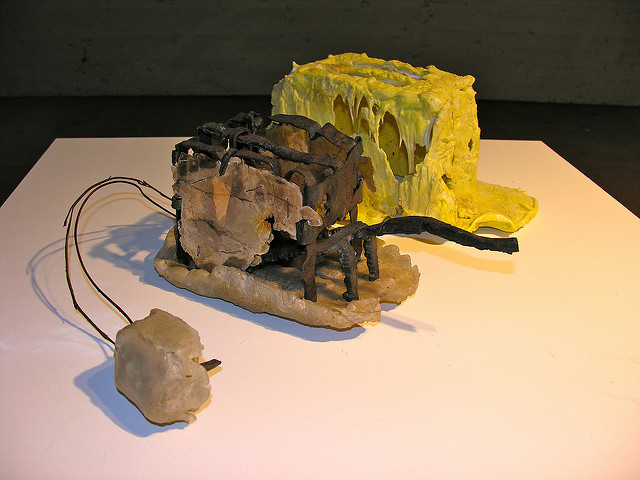
This toaster took 9 months and countless hundreds (or maybe even thousands) of dollars to make. The author mined his own iron, which he then turned into steel. He Distilled copper, and recycled plastic to create the shell of the toaster. The story itself is fascinating to hear, and I won’t spoil much by telling you that in the end the toaster didn’t even work, it didn’t do the one basic thing a toaster needs to do, make toast.
The cost of a very basic new toaster is about $9.99. This $10 toaster could be argued to be infinitely better than the one Mr. Thwaits made. No sane person would think “I need a toaster, I think I’ll make one.” But plenty of very sane manufacturers decide to make when they really should have bought.
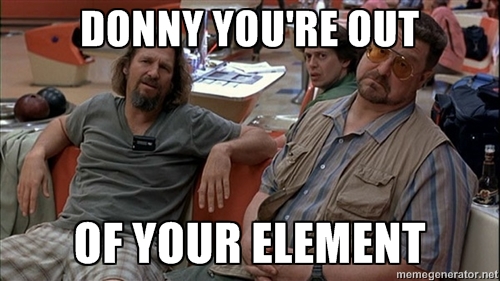
The decision to make versus buy usually comes down to the following:
- Can I make this product cheaper than I can buy it? Specialized companies often times have economies of scale, expertise and experence that someone who’s unfamiliar with the task at hand might not have.
- Does I have excess capacity? If so the cost to manufacture might not be as big a consideration.
- Will the quality suffer if I buy instead of make the item? Will this lesser quality be noticeable by the end user?
- Cash flow concerns; does the company need to front a large amount of cash to get a product bought vs. made?
- Deadline considerations.
And so on. This is by no means a complete list of the M-o-B analysis, and each industry has different concerns. Today we’ll really just be focused on the Make-or-Buy analysis and how it pertains to miles.
Extending This Discussion to Miles
Where does this discussion come into play with Miles and points? Well we have the same decision to make every time we book a ticket, or decide whether to churn and earn with prepaid products or even when we apply for a new credit card.
We’ll break this discussion down by those three examples, and go one by one:
Booking Tickets:
This is an easy to explain Make or Buy type decision. Do you make your ticket (use miles) or Buy one? (Use cash). This is decision #1 in the above M-o-B Analysis, “Can I make this cheaper than I can buy it?”
Knowing your T-Rate helps here. As an example, I’m planning to go to a wedding in Denver in May; there are dozens of options from LAX to Denver. These are all the 1 stop options from LAX only:
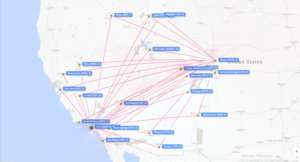
Looking at the length in time of a nonstop versus a 1 stop flight 1 stop adds at least 1.5 hours to this trip. That’s probably not a big deal to some of you; if you T-Rate is low enough, or you just enjoy flying lots of legs you might prefer a stop. For me the decision to make or buy includes this 1.5 hours of time if I’m comparing options:

On the low end there’s a $-144 difference between nonstop and 1 stop (Southwest), and on the high end there’s 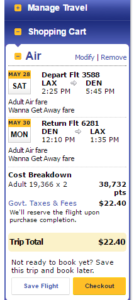 a $93 difference. What this means for me is that if I can book a nonstop flight I should do that, because I’m earning more than my time value taking the nonstop instead of the 1 stop ($150 x 2 pax is my time cost). I go into this a little in a previous booking, “Trading Time for Miles.”
a $93 difference. What this means for me is that if I can book a nonstop flight I should do that, because I’m earning more than my time value taking the nonstop instead of the 1 stop ($150 x 2 pax is my time cost). I go into this a little in a previous booking, “Trading Time for Miles.”
I did a search for award flights and my options are Delta with one stop both ways, or Southwest nonstop both ways. Delta flights would cost me 25,000 miles per person R/T, 50,000 each. But they also would cost me $300 in my time.
Southwest wins, with 2 tickets for 38,732 (transferred 1:1 from chase UR). The value of those points (to me) are just $242 per ticket, and So in this case I should make instead of buy. This is not always the case; Southwest is notorious for being the highest cost carrier for certain flights. They also rarely fly nonstop flights where I want to go. This time things aligned. But had they not, and a lower cost paid nonstop ticket existed I would have not hesitated to buy those seats.
For me, when Southwest flys a route, and is the lowest cost option, I Make; most other times unless flights are in excess of $350 I Buy. Try and identify your Make-or-Buy break-even, it will allow you to very quickly decide if you should book flights with miles, or buy outright. I also try to only earn miles or points in programs that make sense for my Make-or-Buy.
Trumping all of this might be Make-or-Buy decision point #4, Cash flow concerns. If you’re mile rich and cash poor you should take that into consideration.
Churning to Earn (Manufacturing Miles).
There was a time on this blog when I noted Mile manufacturing using the term “MMR,” or Milenomics Mileage Run. This was a time when it made sense (sometimes) to earn miles through manufacturing. I pretty much believe that time has passed for most of us. In fact opportunity costs mean that when you decide to “Make” you better be making your most profitable currency every time. For almost all of you this currency will be:
CASH.
Yes, cash: that extremely flexible, infinitely fungible, non-glamorous rewards program. There’s no glossy brochure for cash, there’s no program with tiers clearly laid out. There’s just Cash.
Here’s a secret some bloggers pretend not to know: you can buy airline tickets, on any airline, any day of the week: with cash. That doesn’t mean cash is the right tool all the time; but it should be your default manufacturing method. In fact all other possible methods should be converted to cash (at a rate that is reasonable to you).
For example: A Chase Ink card that earns 5x UR should be used up to the maximum $50,000 a year. However if there’s a situation where you’re deciding between the Ink and another card that earns a fixed 5% back in cash, you need to compare the two apples-to-apples. To do this you’ll need to convert UR to $. I use a 1.25:1 conversion. 5 UR = 6.25 cents.
Sidebar: I value 1UR at a floor of 1.25 Cents. The reason is twofold: If I needed to I could sell them for that much; I also could book travel at that rate. You might value them higher; if you convert them consistently to another program and get a better true value you might want to increase their value to you. But keep that value fixed; don’t slide the scale to fit the individual booking, at least not when you’re setting your floor.
This is where your T-Rate can come into play. If you’re single or this is your only source of income you’ll probably have no problem Making for 5-8 hours a day. (#2, Excess Capacity) That’s right, there are people who drive around all day, from store to store and end up pocketing hundreds of dollars a day.
My T-Rate has steadily gone up. I have a job, two side businesses that are moderatly successful and a new daughter that I love spending time with. I try to cram all my work into the 9-5pm hours, and the time from 5:01 P.M. until 8:59 A.M. is my family time. I now value my time away from home at $100/hr. Because of that, the economics of churning start to break down. Make-or-Buy helps me limit myself to only churning during 9-5 hours. My lunch break, or a quick trip on the way into work or on the way home.
Consider your circumstances and decide if churning is even worth if for you. If you value your time at $0 you could end up chasing after pennies in the short term instead of dollars in the long term. Sure you can say you want to fly business class and are earning towards that. Don’t make the mistake of assuming the only way you will ever afford business class seats is buy making miles. If you want to there are certainly ways that you can get business class seats, and buy them, for less than the cost to you to make them.
When you convert your thinking from Make to Buy you put your energy behind the best possible option to buy what you want. Stacking discounts, buying tickets from friends using “shadow currencies, even buying miles outright might make sense for some people.
Applying for a Card
This didn’t used to seem like a decision you needed to worry over. But the game changes constantly, and I think some consideration needs to be given to if you should apply for a card(make) or not apply for a card (buy). The number one thing to consider is: Do you have a use for the card.
One thing that’s been heartbreaking about having this blog is that dozens of people have messaged me and told me that they have applied for nearly every card there is, and have miles strewn about in programs that the don’t ever think they’ll use.
Consider skipping the application if you don’t have a clear path to converting the sign up bonus into Cash.
Summary
Whichever you choose, Make or Buy it ultimately is your decision to make. Regardless of which way you go do these two things:
- Always be a master of your decided upon strategy. If you’re going to Make, make miles at the lowest cost, most efficient manufacturing you can. If you’re going to buy, Crank down on price without sacrificing quality as best you can, Get creative in your solutions and ask others for advice.
- Re-evaluate your decision from time to time. Situations change, earning opportunities change, and a Strong Buy can turn into a strong Make easily. Vice versa can also be true, especially during periods of devaluation.
We’ll go into some special cases with respect to valuing miles more tomorrow. For now, where do you fall, Make, or Buy?

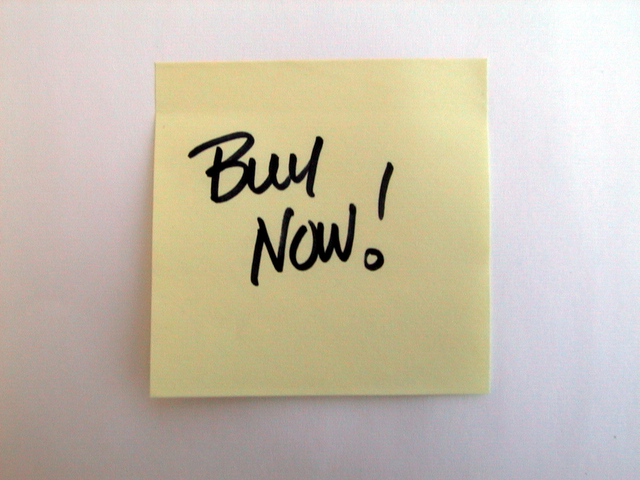
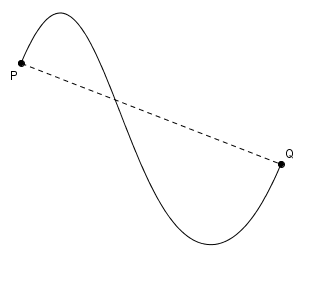

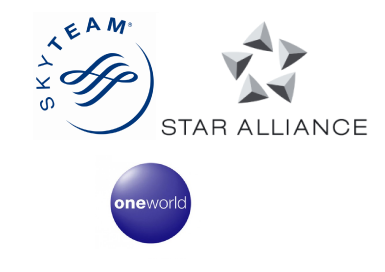
why did you ignore Spirit as one of your flight options (i.e., “there’s a $-144 difference “)?
Also, how did your analysis chart (itamatrix?) include SWA (I thought SWA was not searchable)?
But these are just nits.
In general, I agree that you always need to balance the cost of a flight against your various currencies. This, for me, is the most difficult part of our hobby. Earning is relatively easy compared to getting great value on the spending side.
At some point, I’m gonna call it quits and just simplify by reverting to that best currency of all (cash).
Blue: I probably shouldn’t have excluded spirit in the academic discussion. I excluded them because this is a real booking and there is needed flexibility in our trip, and Southwest has that built in. I will get more into that in my next post. This started as one post and got a little out of hand, at 2,000 words I decided to split it in two 😛 and take out the reasoning behind added value in the flexibility.
As for the SWA flights on ITA Matrix; I made that extra column myself with mspaint to allow for an easy view of all options. I wish they would be searchable in the matrix…
Is it buying if you buy with cash that you made?
Great post!
So Meta. 🙂